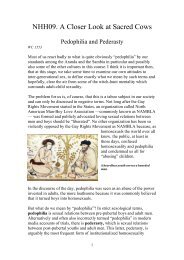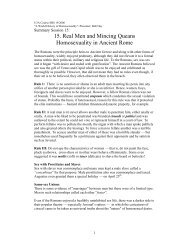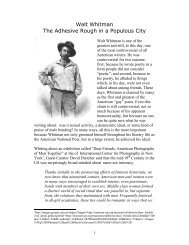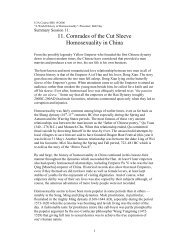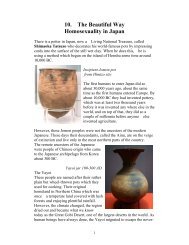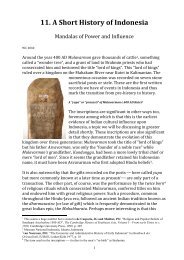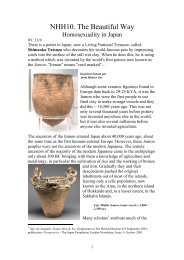7. Boy Wives of the Aranda The Pre-History of ... - BobHay.net
7. Boy Wives of the Aranda The Pre-History of ... - BobHay.net
7. Boy Wives of the Aranda The Pre-History of ... - BobHay.net
Create successful ePaper yourself
Turn your PDF publications into a flip-book with our unique Google optimized e-Paper software.
for business, a matter <strong>of</strong> less than 30 years, <strong>the</strong>ir numbers had fallen to<br />
just 300 or 400. 7<br />
<strong>The</strong> over-all group was divided into five sub-groups 8 : although some<br />
anthropologists thought <strong>the</strong> most Sou<strong>the</strong>rn people were sufficiently<br />
different to form a distinct unit. <strong>The</strong> <strong>Aranda</strong> language is part <strong>of</strong> <strong>the</strong> huge<br />
Pama-Nyungan group which makes up approximately 70% (160 <strong>of</strong> <strong>the</strong><br />
228) indigenous languages <strong>of</strong> Australia.<br />
A useful summary <strong>of</strong> <strong>the</strong> <strong>Aranda</strong> way <strong>of</strong> life is given by Martin J Malone 9<br />
<strong>of</strong> <strong>the</strong> Centre for Social Anthropology and Computing at <strong>the</strong> University<br />
<strong>of</strong> Kent. Much <strong>of</strong> what follows is a synopsis <strong>of</strong> what he wrote.<br />
<strong>The</strong> climate in that part <strong>of</strong> Australia is hot and dry with only two seasons<br />
a year, a long dry and a short wet season. <strong>The</strong> topography varies greatly,<br />
from <strong>the</strong> flatlands in <strong>the</strong> South which are only 20m (70 feet) above sea<br />
level to over 1500m (5,000 feet) on <strong>the</strong> peaks <strong>of</strong> <strong>the</strong> McDonnell Ranges.<br />
<strong>The</strong> driest areas, mostly to <strong>the</strong> south and west, are true desert, although<br />
near <strong>the</strong> Ranges, parts are reasonably well-watered. <strong>The</strong> game available<br />
include kangaroo and emu, wallabies, euros, bandicoots, snakes, frogs<br />
and many species <strong>of</strong> birds. Trees and shrubs in <strong>the</strong> region supplied<br />
timber, gums, herbs and fruits. <strong>The</strong>ir only weapons were spears and<br />
boomerangs. Apparently <strong>the</strong>y had dingoes who helped <strong>the</strong>m hunt but <strong>the</strong>y<br />
were later replaced by dogs which appear to have been kept only for<br />
companionship, not as hunters.<br />
<strong>The</strong> <strong>Aranda</strong>, like all Aboriginal people, were nomadic, constantly moving<br />
from place to place where <strong>the</strong>y knew <strong>the</strong>y could find food. Usually camps<br />
were temporary, little more than a brush shelter, and essentially near a<br />
water-hole. <strong>The</strong>se more-or-less circular lean-tos were occupied by a man<br />
and his wife or wives, children and <strong>of</strong>ten a large number <strong>of</strong> dogs, but <strong>the</strong>y<br />
were used only as to provide shade or some protection against rain. In<br />
warmer wea<strong>the</strong>r, <strong>the</strong> whole family slept outside. People stayed in <strong>the</strong> one<br />
region while <strong>the</strong> food supplies lasted; <strong>the</strong>n <strong>the</strong>y walked to ano<strong>the</strong>r camp<br />
site, but always moving within a circumscribed ancestral territory.<br />
7 Spencer and Gillen 1927<br />
8 E. Strehlow , also Elkin 1938. For distinct group see Tindale 1974: 137, 221<br />
9 Martin J. Malone at http://lucy.ukc.ac.uk/EthnoAtlas/Hmar/Cult_dir/Culture.7827<br />
7



